By Marco Onado, Professor at Bocconi University, Milan and former Commissioner of the Italian public authority responsible for regulating the Italian securities market (CONSOB). Originally published at VoxEU.
The financial crisis has put to the forefront the long-debated issue of banks’ capital adequacy, showing that banks were much more fragile than they (and their regulators) pretended, also because they were allowed to push their leverage to levels much higher than any industrial company, or even a hedge fund, has never dreamt of.
Since then, both governments and the markets have contributed to a substantial increase of banks’ capital in all countries, the Basel regulation has been thoroughly revised, and at long last a cap on banks’ leverage has been introduced. Regulators, both in the US and Europe, are now focussed on convincing the markets that banks are currently robust enough to weather significant external shocks, either macroeconomic or financial. The stress tests that the US ran for the first time in 2009, and Europe will replicate in 2014 (after the overdue realisation of the Single Supervisory Mechanism), are the exercise that should prove that the situation is now under control. In this way, at least for the banks, the horror movie of the financial crisis could find a happy end.
This phase, in particular for Europe, is of the utmost importance, but it is not sufficient to call for a ‘and they lived happily ever after’ solution of the crisis. On the one hand, the level of banks’ capital is (and will remain for the foreseeable future) far from the levels suggested by a growing body of economic literature (Admati and Hellwig 2013). On the other hand – and more specifically – the possible sources of future bank capital (stock issues or retained earnings) can be less copious than expected because of the constraints coming from the market and the present level of banks’ profitability.
This column aims to discuss this issue, looking at a sample of 20 global banks, analysed by R&S, a Mediobanca subsidiary. The main conclusion is that banks have not reached a new equilibrium after the financial crisis and that, if banks really want to be more robust in the future, they must implement radical strategic changes, aiming at deleveraging through reduction of non-core assets and/or achieving substantial reduction of operating costs.
The Present Level of Leverage is Far From Optimal
Notwithstanding the efforts of the recent years, the level of leverage in most banks remains dangerously low. Figure 1 shows that at the end of 2007, only six banks (four of them Italian and Spanish) were above the 3% threshold. Since then the improvement has been significant, but at mid-2013 the ratio on tangible equity to tangible assets (i.e. the measure net of pure accounting items) varies from 1.7% to 6.9%. Three banks do not meet the modest requirement of 3% imposed by Basel-3. If it is reasonable to assume that markets will require a more reassuring limit of 4%, then half of the banks of the sample will still be below this level.
Figure 1. Tangible equity/tangible assets
The increase of bank capital after the financial crisis has been significant, but it came after a long period in which funds from banks to shareholders flew uphill, i.e. new stock issues were lower than dividends and buybacks. This outcome was also the consequence of a short-sighted view of shareholder value applied to all firms, and even to an industry such as banking subject to a capital regulation aiming at “sound and prudent management” (Mayer 2013).
Figure 2 shows that both in Europe and the US in the run-up to the financial crisis, the banks of the Mediobanca sample returned to their shareholders a significant amount of capital. The picture has been reversed after the financial crisis, but:
- Over the entire period of 2000-2012, the overall net flow is either minimal (+ €12.1 billion for Europe), or still negative (- $28.8 billion for the US);
- A significant portion of the net positive flow of the recent years comes from public funds.
Figure 2. Net increase of bank capital
Figure 3 contains the annual net flows for the two areas, and shows that years of significant positive net flows are rare and crucially dependent on the injection of government funds. If the future capital increase of the banks must come from the capital market, the shareholders must reverse their preference in terms or dividends (either ordinary or extraordinary as buybacks). But this is easier said than done. Empirical research shows that the banks’ market share prices are crucially dependent on the level of dividends (Calomiris and Nissim 2013). This contradicts the Modigliani-Miller hypothesis on the irrelevance of the distribution of profits, but is not surprising, as the ‘dividend discount model’ is one of the most common valuation tools (Stiglitz 1974).
Figure 3. Net flows of capital 2000-2011
It is not easy to generalise this finding to the main banking systems because we lack aggregate data on dividends and buybacks, but anecdotal evidence seems to extend the picture shown by the Mediobanca sample to many other important banks. If this is the case, there are at least two important policy implications:
- The first is that public ownership of banks should be no more a taboo. If there are voids in the financial systems (as it is probably the case for the financing of infrastructure and long-term investments in Europe), it could make sense to widen the mandate of existing public institutions, or to build public intermediaries with the specific mission to supply the services neglected by the banks for their lower profitability, even if they could have a positive impact on investment and growth. Also after the financial crisis of the ‘30s, the public initiative proved to be vital for restarting the financial engines of the economy and to overcome the market failures of the private banking system.
- The second policy implication is that the regulators’ guidance on the distribution of earnings used by most regulators in the recent years is not an exceptional and temporary measure, but will remain a permanent tool of the capital adequacy policy. Alternatively stated, investors in bank shares must rediscover, willy-nilly, the virtues of ‘patience’ that seem to be so rare in the last evolution of the financial system (Haldane 2010).
All this means that retained earnings will be the main channel for increasing banks’ capital in the future. But is the present level of bank profits sufficient to allow for a consistent increase of bank capital? The empirical analysis, even on a long-term horizon, shows that in many banking systems, and in particular in those that are typically retail-orientated (such as the Italian) gross and net profitability followed a regular declining trend, and are now at a historically low level (Onado and Lusignani 2013).
Banks’ Gross and Net Profitability Are at a Historical Low Level
In 2013, banks’ profits recovered, notwithstanding the European recession and the heavy toll from nonperforming loans. For the entire sample net profits totalled 36 billion, much higher than the 19.5 of the entire 2012. But even in this case, as Figure 4 shows, most banks recorded a net profitability in the first two quarters (net income on total assets) between 0.1 and 0.2%. Even doubling this figure to estimate the yearly income (which could be fairly optimistic), it is clear that the profitability of the banking business has rebounded from the trough of the most acute phase of the crisis, but is still on a low level.
Figure 4. Return on assets, first-half 2013
This has two consequences.
- First, banks have an incentive to remain on the present levels of leverage to obtain a ‘reasonable’ return on equity.
Figure 5 shows the Roa/Roe relationship for the Mediobanca sample. Banks with a return on assets below 0.2 (on a half-year basis), and in particular those above the trend line, have either to accept a lower level of return on equity, or abandon their strategy based on the maximisation of leverage.
Figure 5. Return on assets vs Return on equity – First-half 2013
This means that banks have to go further in their strategic responses to the crisis – on the one hand pursuing deleveraging through reduction of assets, and on the other hand decreasing significantly their operating costs. On both sides, the response so far has been modest, to say the least.
The net effect is that in the short-run the resistance to substantially decrease the leverage will be very strong.
- The second conclusion that can be drawn from the Figure 5 is that the rate of increase of capital allowed by retained earnings is modest.
For sake of simplicity, assuming a payout ratio of 50%, the half-year return on assets is the ratio of retained earnings to total assets, so the vertical axis measures the rate of increase of banks’ capital. As the (weighted) average is 3.85, it will take about 18 years to double the present level of capital.
Conclusions
To sum up, the situation of the European banks seems far from having reached a new equilibrium. The banks’ responses so far seem to have followed a logic of minor adaptations, and therefore of fierce resistance to fundamental breakthroughs of the regulatory framework (witness the strong lobbying against ring-fencing, the leverage ratio, etc). This strategy can be considered successful only if the market considers safe a 3% level of capital, and shareholders accept lower returns (through lower risk premia) and lower payouts than in the past. The two things look contradictory. In a business that remains highly leveraged, the required rate of return should be significant.
Therefore, banks will have to look at other strategic (and endogenous) responses, such as reduction of non-core assets and slashing of operating costs. On both fronts, the responses so far have been less ‘transformational’ than expected (Llewellyn 2012). But, as banks cannot be considered in a steady state, the title of a famous movie will apply: ‘something’s gotta give’.
References
Admati, A and M Hellwig (2013), The bankers’ new clothes. What’s wrong with banks and what to do about it, Princeton University Press, Princeton.
Calomiris, C and D Nissim (2013), “Crisis-Related Shifts in the Market Valuation of Banking Activities”, Columbia Business School Research Paper No. 13-31.
Haldane, A (2010), “Patience and finance”, Speech at the Oxford China Business Forum, Beijing, 9 September.
Llewellyn, D T (2012), “The evolution of bank business models: pre- and post-crisis”, Paper presented at Joint SUERF/ICFR Conference, Future Risks and Fragilities for Financial Stability, London
Mayer, Colin (2013), Firm Commitment: Why the corporation is failing us and how to restore trust in it, Oxford University Press, Oxford.
Onado, M and G Lusignani (2013), “A long-term approach to Italian banks’profitability. Paradise lost?” The Journal of Financial Perspectives, vol.3
Stiglitz, J (1974), “On the Irrelevance of Corporate Financial Policy”, The American Economic Review 64(6), 851-66, December.
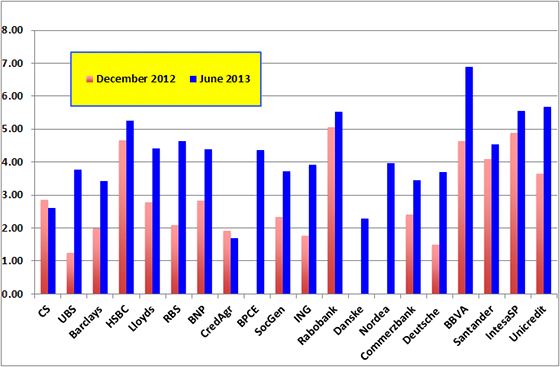
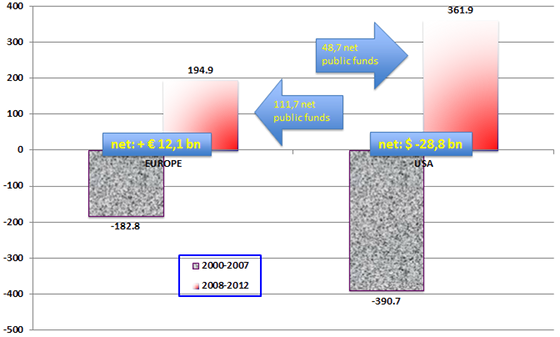
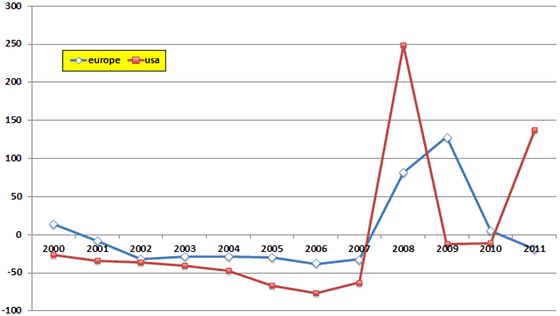
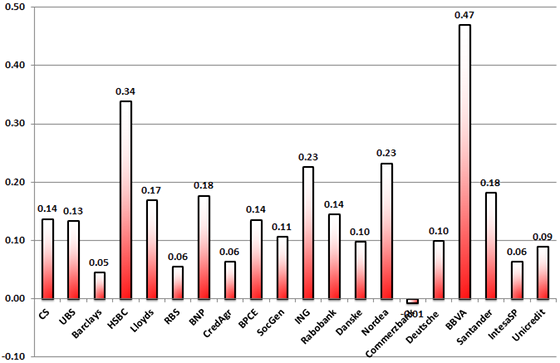
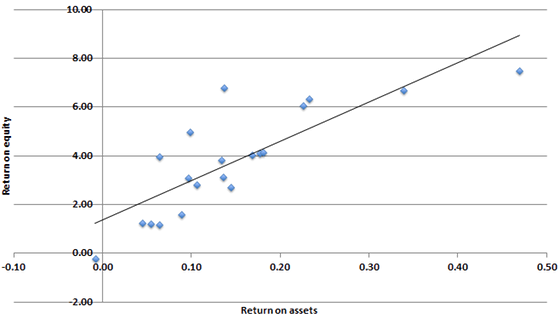


“… public ownership of banks should be no more a taboo”.
That’s precisely what the Troika (Commission+ECB+IMF) are working the hardest against. Yesterday I read that the Western Basque public savings banks will not anymore be allowed to own more than 30% of capital of their joint company Kutxabank, so they will be forced to sell stock and we citizens will lose even more control over our public banks, whose quality has decreased notably in the last few years, partly because of the crisis but mostly because of neoliberal EU impositions. Another imposition is that not more than 25% of profits will be allowed to expend in the “social work”, a traditional destination of public banks’ earnings, which co-finance all kind of charities such as elderly homes or grassroots sport.
This is of course a pan-EU measure not only affecting us and implies (again) that there are no democratic social options within its ultra-capitalist dogma. The EU is therefore shooting itself on the foot, because, on one side, such measures are highly ineffective (except for banksters maybe) and, on the other, it continues eroding its legitimacy by becoming a mere tool for the oligarchs to squeeze the peoples of the continent.
Here in the US bank stock dividends have been smaller. And the banks’ “profitability” has been advertised proudly. But they’re still skidding along the bottom because they can’t overcome their leverage demands. And the world of good, quick investment return is tapped out. This “retail” banking is a direct contradiction of the way capitalism is supposed to work – that a company that is profitable can pay good dividends and attract investors. But in banking when that model is followed it sets off the perfect storm right at the heart of the system. All that profit always seeks a new and higher return than the last one. I keep thinking of bread dough rising. Private banking is just wild and crazy yeast. And so they resort to supplying their own credit (!) and churning an exhausted economy. And it is as Ann Pettifor says – we should never allow an enterprise, banksters, to create their own commodity because none of the checks and balances in “capitalism” can control it. That alone is an air-tight reason for nothing but public banking.
The first is that public ownership of banks should be no more a taboo.
Why? Normally, a national government is monetarily sovereign and has no need to ever borrow. As for the private sector, government-privleged or government-owned banks violate Equal Protection Under the Law in favor of the so-called “credit worthy” at the expense of everyone else. Otoh, 100% private banks with 100% voluntary depositors would have to pay relativily high real interest rates to attract deposits – even to the poor and other non or less creditworthy. And if business does not like high real interest rates then let it issue more shares to finance investment.
Btw, note that if a bank never issued debt (Liabilities = 0), but always used its own common stock to purchase assets, then it would always be 100% capitalized since Equity would equal Assets.
But hey, why share when government privilege can render one’s liabilities mostly virtual anyway?
Mostly virtual, that is, for the banking cartel AS A WHOLE (Where else besides the banking cartel can deposits be stored and transacted risk-free? That’s a huge reason why we need in the US a Postal Savings Service that makes no loans and pays no interest so government deposit insurance can be abolished.) Yes, there is competition between the thieves but they are united in a cartel against the rest of mankind.
Unfortunately, most of the post-2008 reform in the western economies has been pushed by an odd coalition of neoliberals and populists in the direction of making banks more capitalist and “self-reliant” and diminishing the public role in finance, rather than moving in the direction of socialized or public finance. The capitalists succeeded in getting everyone up in arms about bailouts, and the result is that rather than reducing the role of private profitability as the driver of economic development, we are moving back toward making it the sole driver.
By the way, in the era of the 401K, where the retirement security of the population depends on the profitability of private funds invested in banks, then increasing the degree to which stockholders are on the hook for bank losses means increasing the vulnerability of retirement savings. If we ever have another financial crisis with these high capital requirements, retirements savings will suffer another colossal hit, which will give us another massive negative wealth effect, sharp drop in aggregate demand, employment and the rest.
By the way, in the era of the 401K, where the retirement security of the population depends on the profitability of private funds invested in banks, then increasing the degree to which stockholders are on the hook for bank losses means increasing the vulnerability of retirement savings. Dan K
Good one, Dan! Using pensioners as a human shield for the banks! But:
1) It is government privileges, especially the lack of a proper Postal Savings Bank, and the existence of government deposit insurance instead that allows banks to leverage so much and thereby create huge boom-bust cycles in the first place.
2) But in any case, Social Security should not be seen as a suppliment to private pensions but vice versa so SS needs to be a lot more generous.
3) Old folks should be ashamed their pensions are invested in the thieving, economically and politically destabalizing government-backed credit cartel. I know I would be.
It would make no difference if there were no banks, but people’s retirement savings were all invested in other forms of private equity – which you seem to love.
It would make no difference if there were no banks, …
Then’s let’s remove all explicit and implict privileges for the banks and see, eh? And if that caused all banks to shutter then, your words, “It would make no difference.”
You’re the one who should love equity and sharing, shouldn’t you? Or is power what Progressives are all about?
You should repent. If you can’t fool me, do think you’ll fool God?
“Equity” in the sense in which it is used to refer to ownership shares in a company has nothing to do with sharing or with the concept of equity as applied in relation to social justice.
Next thing you will be telling me is that if the Walton family creates a national chain of plantations in which they own all the shares, and the rest of us become sharecroppers working for them, then we will live in a wonderful sharing economy.
Oh feel the sharing! Feel the equity!
“Equity” in the sense in which it is used to refer to ownership shares in a company has nothing to do with sharing or with the concept of equity as applied in relation to social justice. Dan K
Only maybe, yet common stock as private money, instead of a government-backed (even implicity) credit cartel, would have much more justly shared wealth and power instead of unjustly concentrating them. And since shares in Equity are endogenous and require no borrowing or usury then steady growth might last forever with no necessary bust ever.
*Yet common stock as private money does NOT REQUIRE growth, much less the exponential growth that the current credit for usury system does.
Have you missed where I call for a one-time equal redistribution of the common stock of all large corporations? And Steve Keen’s “A Modern Debt Jubilee?” And land reform similiar to Leviticus 25?
The reason I can call for such things is I realize that government-enabled credit creation is theft for the sake of the banks and other equity owners, the so-called creditworthy, and that theft REQUIRES restitution.
Leviticus 25:44-46 (New International Version)
44 “‘Your male and female slaves are to come from the nations around you; from them you may buy slaves. 45 You may also buy some of the temporary residents living among you and members of their clans born in your country, and they will become your property. 46 You can bequeath them to your children as inherited property and can make them slaves for life, but you must not rule over your fellow Israelites ruthlessly.
Hint: My comments are short and to the point so you have no excuse for not knowing my positions by now. No problem, you just continue to underestimate me and thereby reduce your own credibility.
I see my Control-F test for the words fraud and crime amusingly fails again.